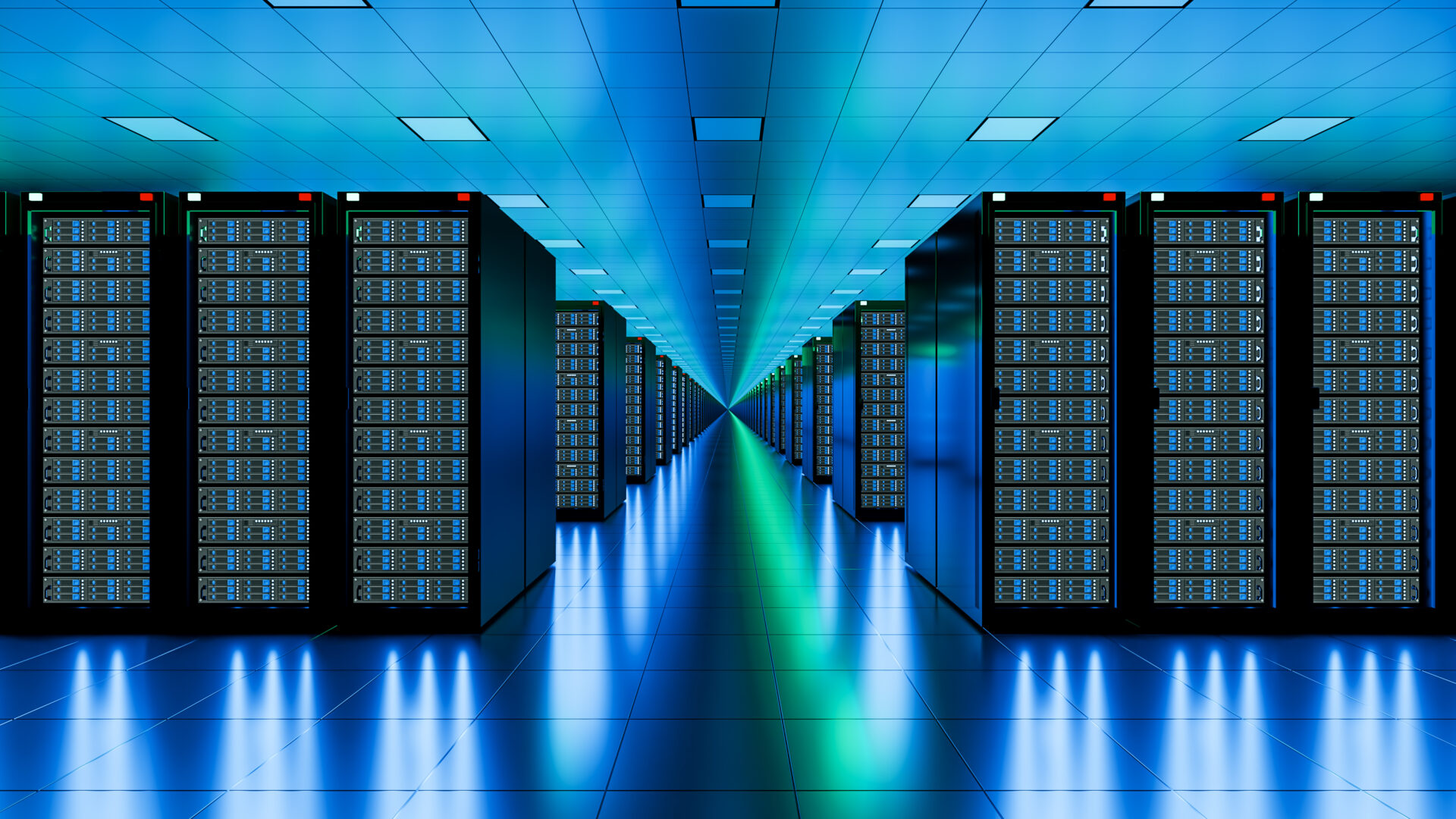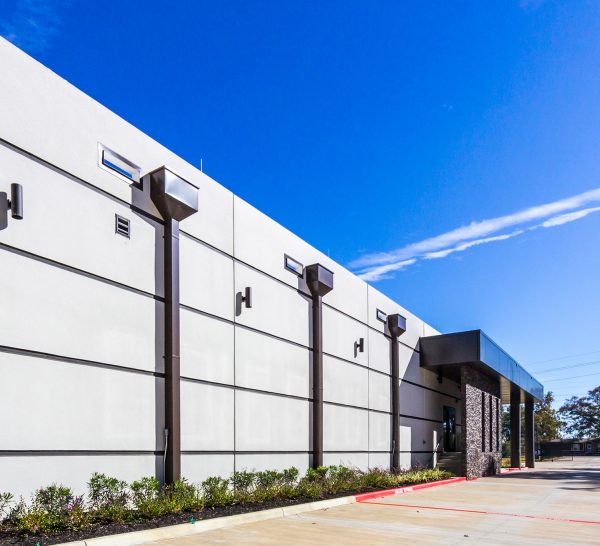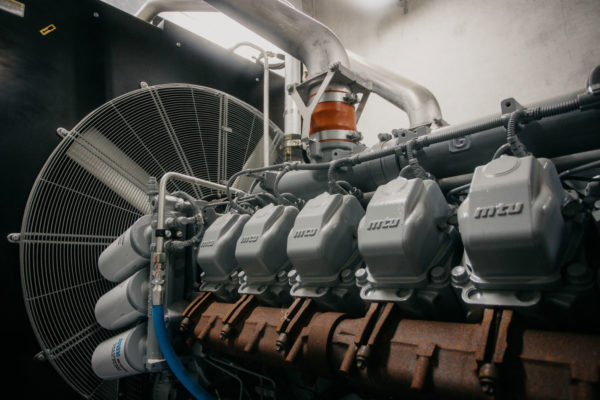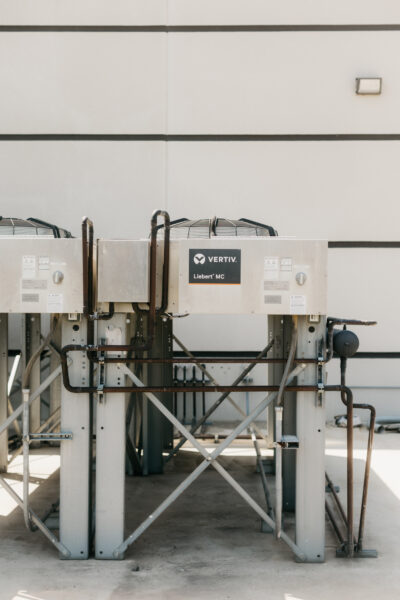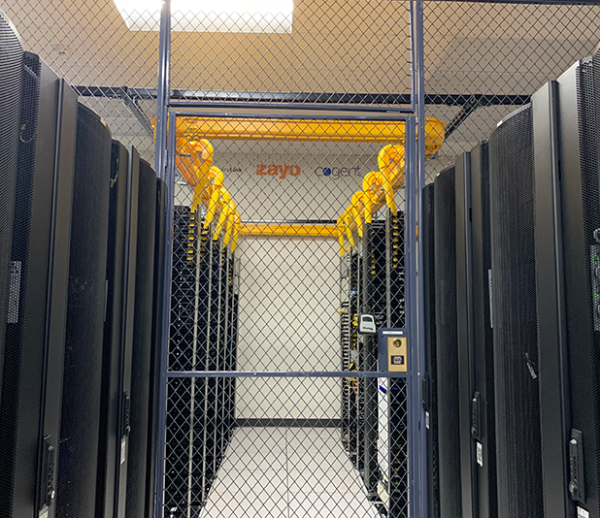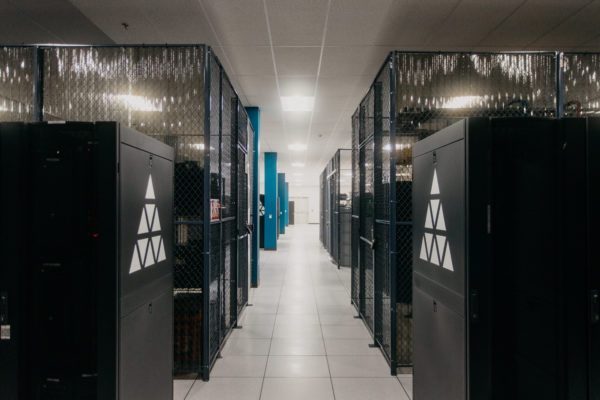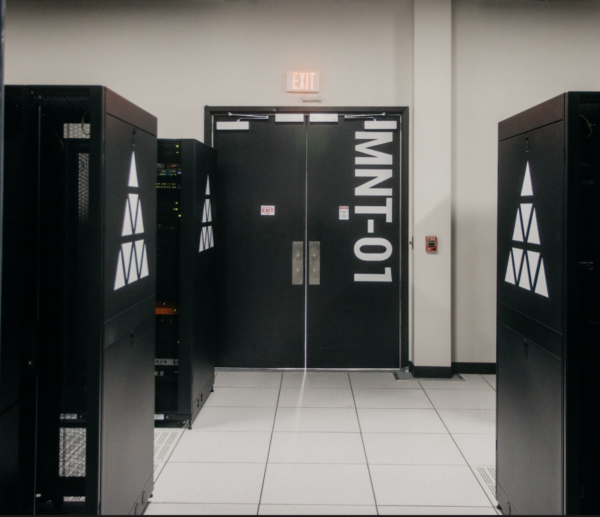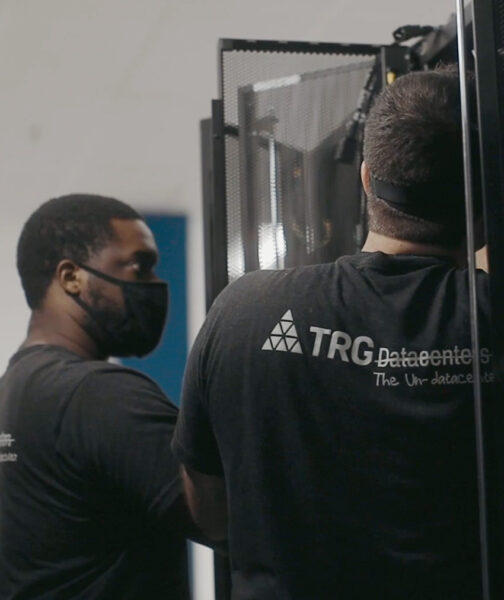A hyperscale data center is like a traditional data center, except everything is done on an enormous scale – they have thus been built to meet the specific needs of large scale organizations.
As the name suggests, hyperscale data centers are vast facilities, which are capable of fulfilling storage needs that are far higher than an SME.
To understand how these facilities scale to meet the demands of their users, it’s essential to consider two primary dimensions: horizontally and vertically.
How Does a Hyperscale Data Center Work?
The core functionality of a hyperscale data center revolves around its ability to scale both horizontally and vertically.
This means that additional computing power and storage can be added seamlessly without disrupting the operations or services being delivered.
Horizontally
Scaling horizontally, also known as scale-out, involves adding more machines or nodes to a pool to increase capacity or throughput.
With hyperscale data centers, this means expanding the facility’s resources by adding more servers, storage units, or networking gear to handle additional load.
This approach is particularly well-suited to cloud computing environments, where the demand for resources can fluctuate dramatically and rapidly.
Horizontal scaling allows hyperscale data centers to be incredibly flexible and responsive to changing demands. When more processing power, storage space, or networking capacity is needed, additional units can be seamlessly integrated into the existing infrastructure without disrupting service.
Vertically
Vertical scaling, or scale-up, involves increasing the capacity of existing machines or systems by adding more powerful components, such as faster CPUs, more RAM, or larger storage drives.
In hyperscale data centers, vertical scaling is used in conjunction with horizontal scaling to maximize the efficiency and performance of the infrastructure.
By upgrading the capabilities of individual nodes, hyperscale data centers can handle more intensive workloads without necessarily increasing the number of machines. This can be particularly important for applications that require high-performance computing resources or for databases that benefit from having large amounts of memory.
Vertical scaling also allows for the consolidation of workloads, which can improve performance and reduce latency by minimizing the distance data must travel between components.
However, there are limits to how much a single machine can be scaled up, which is why hyperscale data centers typically rely on a combination of both horizontal and vertical scaling strategies.
Benefits of Hyperscale Data Centers
The unique design and architecture of hyperscale data centers offer several advantages over traditional data centers, making them the preferred choice for large-scale enterprises, cloud providers, and tech giants.
Some key benefits include:
1. Scalability
One of the hallmark features of a hyperscale data center is its ability to scale rapidly and efficiently. This scalability is not just in terms of physical space but also computing power, storage capacity, and network infrastructure.
Hyperscale data centers are designed to grow horizontally by adding more servers or vertically by upgrading existing hardware, allowing them to easily accommodate the increasing demands of large-scale organizations.
2. Automation
Hyperscale data centers rely heavily on automation to manage and maintain their vast infrastructures. Automation is used for a wide range of tasks, from server provisioning and load balancing to security and disaster recovery.
This reduces the need for human intervention, lowers the risk of errors, and improves operational efficiency and reliability.
3. Energy Efficiency
Given their size and the amount of power they consume, hyperscale data centers must prioritize energy efficiency to minimize operational costs and reduce their environmental impact.
This is achieved through advanced cooling technologies, energy-efficient hardware, and the use of renewable energy sources. The design and layout of the facility also play a crucial role in maximizing airflow and reducing cooling requirements.
4. High Density
Hyperscale data centers are characterized by their high-density setups, where a large number of servers are packed into a relatively small physical space.
This not only maximizes the use of space but also enhances the efficiency of cooling systems and power distribution.
High-density configurations require sophisticated management systems to ensure optimal performance and prevent overheating.
5. Redundancy and Reliability
To ensure high availability and minimize downtime, hyperscale data centers implement extensive redundancy at all levels of their architecture, from power supplies and cooling systems to network connections and data storage.
This redundancy is complemented by robust disaster recovery and fault tolerance mechanisms, ensuring continuous operation even during hardware failure or other disruptions.
6. Network Infrastructure
The network infrastructure of a hyperscale data center is designed to handle massive amounts of data traffic with minimal latency. This involves the use of high-speed networking technologies, efficient routing protocols, and direct connections to major internet backbones. The network architecture must also be flexible and scalable to accommodate changing traffic patterns and growth.
7. Security
With the vast amounts of sensitive data they store and process, hyperscale data centers implement stringent security measures to protect against physical and cyber threats.
This includes multi-layered security protocols, access controls, surveillance systems, and regular security audits. Cybersecurity measures are particularly emphasized, with advanced encryption, firewalls, and intrusion detection systems in place.
8. Software-Defined Infrastructure (SDI)
In hyperscale data centers, much of the hardware is abstracted by software. This is called Software-Defined Infrastructure (SDI), which includes software-defined networking (SDN), storage (SDS), and data centers (SDDC).
This allows for more flexible management, enabling dynamic reallocation of resources in real-time to meet changing demands.
What’s the Difference Between a Data Center and a Hyperscale Data Center?
The term data center refers to any building that’s dedicated to the housing of IT equipment and servers, for the use of a whole range of different businesses and organizations. Data centers provide a fast and reliable service to businesses that rely on their IT infrastructure, and house data in a safe and secure way off-site.
Hyperscale data centers fulfill a similar role, but they do it in a different way. The key difference between typical data centers and hyperscale ones is of course the size of them. Hyperscale data centers are much bigger than other data centers. They therefore have capabilities that far exceed those of a typical on-prem data center.
Hyperscale data centers are more similar to colocation facilities, but specifically designed to meet the technical and operational needs of hyperscale companies like Amazon or IBM.
As they functions similar to hyper-scaled colocation facilities, one of the key benefits is the fact that they can take advantage of economies of scale. A typical hyperscale data center will contain over 5,000 servers and it’s not uncommon to see customers use an entire dedicated floor within a data center – if not an entire building. This larger dedicated space allows higher level of power per deployment (potentially up to 50 megawatts in one deployment).
Colocation vs Hyperscale
We covered a few of the similarities above, but let’s dive deeper into the relationship between these two. Colocation and hyperscale are ultimately the same type of service. As mentioned above, the basic difference is the sheer size.
Typically, hyperscale data centers are 10,000 square feet or more and anything smaller than that would be considered a standard colocation data center.
How Big Are Hyperscale Data Centers?
Hyperscale facilities are generally considered those that are built or leased 20+ MW. That number will then grow by between 1-3 MW at a time.
The Inner Mongolian Information Hub is one of the largest hyperscale data centers on the planet. It spans an incredible 10.7 million square feet and provides services to China Telecom. This Hohhot hyperscale data center is in good company too, as there are several other huge data centers in the area.
Other examples of enormous hyperscale data centers include the Hohhot Data Center, which covers 7.7 million square feet. Owned by China Mobile, this vast facility is also located in Hohhot, not far from the Inner Mongolian Information Hub.
Nevada is also home to some colossal data centers. The Citadel Campus, which is owned by Switch, spans a huge 7.2 million square feet. This data center is particularly impressive as it’s entirely powered by renewable energy sources. It also has a guaranteed latency of 4.5 milliseconds (ms) to Silicon Valley.
Who Are Hyperscale Data Centers for?
There are relatively few hyperscale facilities in the US – and the reason is because they are only suitable for the largest companies. Any business deploying less that 20 MW won’t need to think about hyperscale and can rely on more typical colocation facilities.
Companies such as Google, Amazon, IBM and Microsoft, on the other hand, all use hyperscale data centers. One thing unites thes companies is that the briefest outage is business-critical. Usually, businesses using hyperscale data centers are those that sell technology management services. In other cases, these companies could be making a profit via the websites and apps being supported by the data center.
Companies that require the use of hyperscale data centers tend to need unparalleled levels of reliability and security, because without their online services, they would immediately cease trading. Hyperscale data centers deliver this, in a way that even the largest and most complex businesses can depend on.
Challenges Faced by Hyperscale Data Centers
Despite the numerous advantages, hyperscale data centers also face several challenges.
As businesses and cloud providers rely more on these infrastructures, addressing these challenges becomes critical to ensuring their continued growth and success.
Energy Consumption
While hyperscale data centers are optimized for energy efficiency, the sheer size and capacity of these facilities mean that they still consume massive amounts of power.
Finding sustainable solutions to reduce energy consumption and carbon emissions is a top priority for operators.
Environmental Impact
The construction and operation of hyperscale data centers can have a significant environmental impact.
From land use to water consumption for cooling systems, hyperscale facilities must balance their rapid growth with sustainability initiatives.
Infrastructure Complexity
Managing the vast network of servers, storage, and networking components in a hyperscale data center is a complex task.
Automation helps reduce some of the burdens, but the infrastructure still requires skilled personnel to maintain and optimize systems.
Security Threats
With hyperscale data centers housing vast amounts of sensitive data, they are prime targets for cyberattacks.
Keeping security measures constantly updated and able to detect and mitigate evolving threats is essential to maintaining data integrity.
Examples of Hyperscale Data Centers
To better understand hyperscale data centers, let’s look at some real-world examples:
Amazon Web Services (AWS)
AWS operates hyperscale data centers worldwide to power its cloud services, including storage, machine learning, analytics, and more. AWS continues to expand its hyperscale operations to meet the growing demand for cloud services from businesses of all sizes.
AWS data centers are designed with high levels of automation, security, and energy efficiency, making them a benchmark for hyperscale architecture. AWS regions are geographically distributed to provide low latency and high availability for customers worldwide.
Google Cloud
Google Cloud’s hyperscale data centers are some of the most advanced in the world. Known for their energy-efficient design, Google’s facilities leverage AI-powered cooling systems that significantly reduce power consumption.
Google’s hyperscale infrastructure supports services like Gmail, Google Drive, YouTube, and Google Cloud, all requiring high-speed data processing and storage capabilities.
Additionally, Google has made significant efforts to power its data centers using 100% renewable energy.
Microsoft Azure
Microsoft Azure operates a vast network of hyperscale data centers globally to support its cloud services and enterprise solutions. Azure data centers are known for their modular design, allowing Microsoft to scale operations efficiently.
Microsoft has also invested heavily in renewable energy to power its data centers and is committed to becoming carbon-negative by 2030.
Azure supports various enterprise services, including artificial intelligence (AI), machine learning, Internet of Things (IoT), and blockchain solutions.
Facebook (Meta)
Meta’s hyperscale data centers support its massive social media platforms, including Facebook, Instagram, and WhatsApp.
These facilities are engineered for energy efficiency and are located across multiple regions to ensure global service availability.
Meta has also pioneered advancements in server technology and open-source hardware through the Open Compute Project (OCP), which aims to reduce energy consumption while improving performance.
Meta’s hyperscale infrastructure is also designed to support its growing focus on augmented reality (AR) and virtual reality (VR) technologies.
Alibaba Cloud
As one of the largest cloud service providers in Asia, Alibaba Cloud operates hyperscale data centers to power its e-commerce platforms and cloud services.
Alibaba’s data centers are optimized for high availability and offer services like big data analytics, machine learning, and storage to millions of customers worldwide.
The company also focuses on making its hyperscale operations more sustainable, integrating renewable energy sources and innovative cooling technologies.
The Future of Hyperscale Data Centers
As technology advances and businesses increasingly rely on digital infrastructure, the role of hyperscale data centers will only become more critical.
Key trends that will shape the future of hyperscale data centers include:
Edge Computing Integration
While hyperscale data centers are centralized, the growing demand for low-latency applications like 5G, IoT, and real-time analytics is driving the rise of edge computing. In the future, we will see more integration between hyperscale data centers and edge locations.
Edge computing nodes will work in tandem with hyperscale data centers to process data closer to the source, reducing latency and improving performance for time-sensitive applications.
Increased Focus on Sustainability
As the environmental impact of data centers becomes a more pressing concern, operators will continue to innovate in sustainability efforts.
This includes investing in more renewable energy sources, developing even more efficient cooling technologies, and improving data centers’ overall carbon footprint.
Companies like Google, Amazon, and Microsoft are already in charge, committing to renewable energy and ambitious carbon-neutral goals.
AI and Automation
Artificial intelligence and automation technologies will continue to play an integral role in optimizing hyperscale data center operations.
From energy management and cooling systems to predictive maintenance and security, AI-driven solutions will help improve efficiency and reduce operational costs.
As workloads become more complex, automation will enable faster, more intelligent decision-making within data centers.
Quantum Computing
Although still in its infancy, quantum computing holds the potential to revolutionize hyperscale data centers.
Quantum computers can process complex computations far faster than traditional computers, potentially transforming how data is stored, processed, and analyzed.
While mainstream adoption is still years away, hyperscale operators are already investing in research and development to explore how quantum computing can be integrated into future data center operations.
Software-Defined Data Centers (SDDC)
The shift towards software-defined infrastructure will continue to grow, allowing hyperscale data centers to become even more agile, efficient, and scalable.
Software-defined networking, storage, and compute resources enable real-time adjustments based on demand, reducing the need for physical intervention and making data centers more adaptable to varying workloads.
This flexibility will be essential as businesses scale their digital operations and explore new technologies like blockchain and AI.
Get More Advice on Hyperscale Data Centers
We understand the importance of robust infrastructure in powering your business. Our facilities are designed with scalability and security in mind, ensuring that your operations remain agile and secure as you grow.
Whether you want to expand your IT capabilities or improve your data management, our team of experts is here to help you navigate the complex world of hyperscale data centers.
Contact us today to learn more about how we can support your data needs and drive your business forward.
